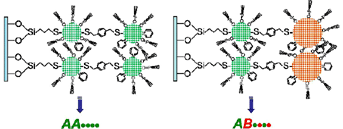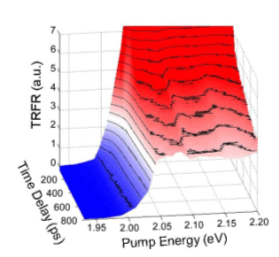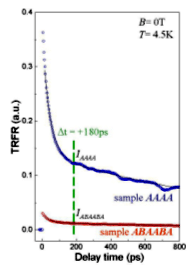Investigations into chemically synthesized CdSe QDs have revealed spin coherence times exceeding several nanoseconds at room temperature, limited by inhomogeneous broadening. However, the integration of these nanometer- scale building blocks into large-scale functional spintronic devices, while maintaining efficient and tunable spin coupling among QDs, has been extremely challenging.

We have implemented a controlled bottom-up layer-by-layer self-assembly scheme to construct artificial solids of semiconductor QDs bridged by organic molecules, as shown in the right figure.
The advantage of such a layer-by-layer assembly scheme is that each layer is independent of the others during the sample preparation. Thus, a variety of multilayer configurations and molecular bridges can be achieved by simply changing the type of QD solutions and/or the dithiol linking molecules used for each step. Specifically, the linking molecule used in our devices is 1,4-benzenedimethanethiol and two different sizes of CdSe QDs are employed (3.4 and 7.0 nm QDs, denoted as A and B below, respectively) with a large energy separation between their first exciton states (EgA and EgB):

The right figure shows typical TRFR data from two control samples at B=0.8T for a four-layer sample AAAA and a two-layer sample BB. The TRFR signal from sample BB is observed over a broad probe energy range (Eprobe=1.97-2.33 eV), and yields a constant precession frequency γB = 20.72 ± 0.21 GHz. Similarly, TRFR data recorded in sample AAAA exhibit comparable spin dynamic features over the detectable range Eprobe=2.26-2.44 eV (limited at high energies by the tuning range of the probe laser) but with a different characteristic Larmor frequency γA = 23.39 ± 0.26 GHz.

To the left we plot typical TRFR traces of a mixed structure ABAABA at three different probe energies with pump energy tuned to the first exciton state of the 7.0nm QDs. Since the pump energy is less than the first exciton state of the smaller QDs, carriers are only expected to be excited in the larger QDs. Remarkably, however, TRFR signal is observed at the higher probe energies of the smaller QDs. In addition, in contrast to the Figure above, the spin dynamics here exhibit a strong dependence on the probe energy (note the temporal beating pattern highlighted in the middle trace of Eprobe=2.32eV).

The evolution of the TRFR signal of sample ABAABA as a function of probe energy can be more clearly seen in the figure below, which shows the normalized FFT of a series of measured TRFR data with probe energies scanned from 1.97 to 2.44 eV while holding the pump energy to the first exciton state of 7.0nm QDs. Two Larmor frequencies observed in this hybrid sample, 20.82 ± 0.26 and 23.63 ± 0.26 GHz can be attributed to the coherent spin dynamics of carriers in the 7.0nm (B) and 3.4nm (A) QDs, respectively. Specifically, the presence of the characteristic γA of 3.4nm QDs at higher probe energies suggests that spins are coherently transferred from larger to smaller QDs. Further more, probing at intermediate energies (for example, Eprobe=2.32 eV), spins precessing at both Larmor frequencies can be observed, leading to a temporal beating. Line cuts at three different probe energies are also shown.

The left figure further verifies that spins excited in 7.0nm QDs are indeed transferred to 3.4nm QDs. In this experiment, we measure the degree of spin accumulation in 3.4nm QDs as a function of pump energy (Epump) while holding the Eprobe at 2.43 eV at zero field. The data show a clear onset feature near 2.04 eV, which is coincident with the first exciton state of 7.0nm QDs. The spin migration from 7.0nm to 3.4nm QDs is therefore confirmed by the sudden growth of TRFR amplitude as pump energy is tuned across the absorption threshold of 7.0nm QDs.

Comparison of spin dynamics of 3.4nm QDs resulting from either direct spin injection (sample AAAA) or spin transfer from 7.0nm QDs (sample ABAABA) is shown on the right.

Significantly, there is no observable time and phase delay for spin to transfer from 7.0nm QDs to 3.4 nm QDs within the time resolution of our apparatus (~300fs). We further estimate the efficiency of spin transfer by calculating the spin transfer percentage (STP) as following:

where IAAAA and IABAABA are the amplitudes of normalized zero field TRFR data (recorded at the same laser excitation power) of sample AAAA and sample ABAABA at fixed delay Δt, and γAAAA and γABAABA are the optical absorption of sample AAAA and sample ABAABA at their excitation energies. Therefore, the STP is ~11.8% at 4.5K.
This observed near-instantaneous spin coherence transfer persists up to room temperature. The figure below shows the evolution of Larmor precession at 200K measured at three different probe energies while spins are injected into 7.0nm QDs in sample ABAABA. The spin transfer kinetics exhibit a very similar dependence on Eprobe as seen at low temperatures. More significantly, the STP slowly increases as the temperature is raised from 4.5K to 25 K, with a sharper increase thereafter. As the temperature is raised above 80K, the STP approximately doubles and then saturates at higher temperatures.

These spin transfer measurements reveal that small conjugated molecules can serve not only as physical links for hierarchical assembly but also as natural media for shuttling quantum information between QDs.
To learn more about our studies, please refer to "Coherent spin transfer between molecularly bridged quantum dots', M. Ouyang and D.D Awschalom, Science 301, 1074 (2003) , and related article "Quantum dots chemically wired for spintronics", Science 301, 580 (2003).